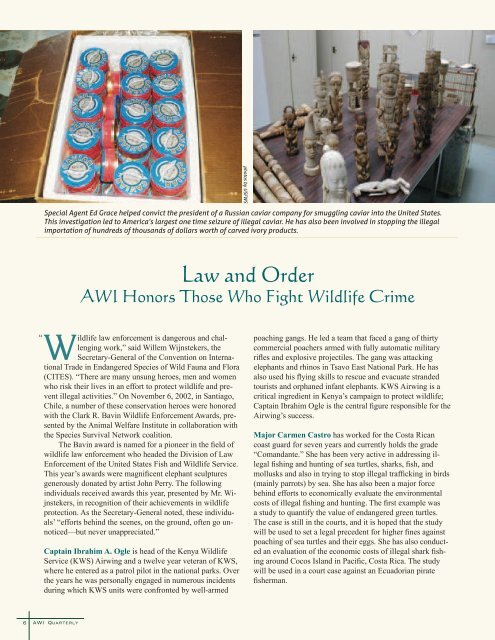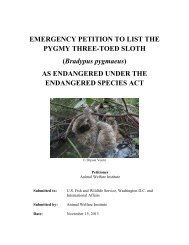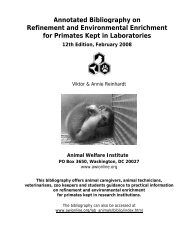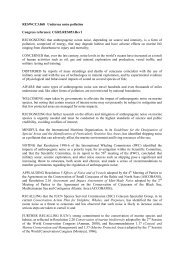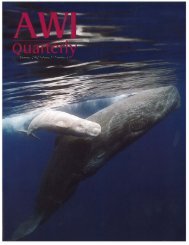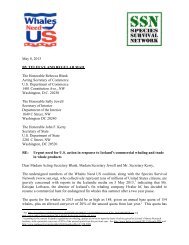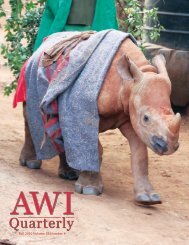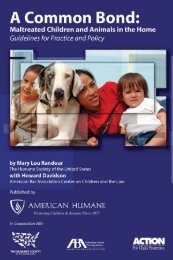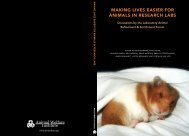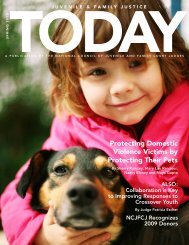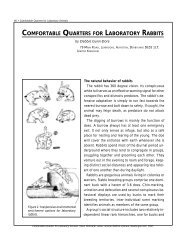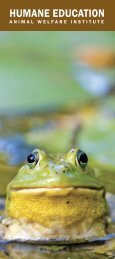Create successful ePaper yourself
Turn your PDF publications into a flip-book with our unique Google optimized e-Paper software.
Special Agent Ed Grace helped convict the president of a Russian caviar company for smuggling caviar into the United States.This investigation led to America’s largest one time seizure of illegal caviar. He has also been involved in stopping the illegalimportation of hundreds of thousands of dollars worth of carved ivory products.“ Wildlife law enforcement is dangerous and challengingwork,” said Willem Wijnstekers, theSecretary-General of the Convention on InternationalTrade in Endangered Species of Wild Fauna and Flora(CITES). “There are many unsung heroes, men and womenwho risk their lives in an effort to protect wildlife and preventillegal activities.” On November 6, 2002, in Santiago,Chile, a number of these conservation heroes were honoredwith the Clark R. Bavin Wildlife Enforcement Awards, presentedby the <strong>Animal</strong> <strong>Welfare</strong> <strong>Institute</strong> in collaboration withthe Species Survival Network coalition.The Bavin award is named for a pioneer in the field ofwildlife law enforcement who headed the Division of LawEnforcement of the United States Fish and Wildlife Service.This year’s awards were magnificent elephant sculpturesgenerously donated by artist John Perry. The followingindividuals received awards this year, presented by Mr. Wijnstekers,in recognition of their achievements in wildlifeprotection. As the Secretary-General noted, these individuals’“efforts behind the scenes, on the ground, often go unnoticed—butnever unappreciated.”Captain Ibrahim A. Ogle is head of the Kenya WildlifeService (KWS) Airwing and a twelve year veteran of KWS,where he entered as a patrol pilot in the national parks. Overthe years he was personally engaged in numerous incidentsduring which KWS units were confronted by well-armedphotos by USFWSLaw and OrderAWI Honors Those Who Fight Wildlife Crimepoaching gangs. He led a team that faced a gang of thirtycommercial poachers armed with fully automatic militaryrifles and explosive projectiles. The gang was attackingelephants and rhinos in Tsavo East National Park. He hasalso used his flying skills to rescue and evacuate strandedtourists and orphaned infant elephants. KWS Airwing is acritical ingredient in Kenya’s campaign to protect wildlife;Captain Ibrahim Ogle is the central figure responsible for theAirwing’s success.Major Carmen Castro has worked for the Costa Ricancoast guard for seven years and currently holds the grade“Comandante.” She has been very active in addressing illegalfishing and hunting of sea turtles, sharks, fish, andmollusks and also in trying to stop illegal trafficking in birds(mainly parrots) by sea. She has also been a major forcebehind efforts to economically evaluate the environmentalcosts of illegal fishing and hunting. The first example wasa study to quantify the value of endangered green turtles.The case is still in the courts, and it is hoped that the studywill be used to set a legal precedent for higher fines againstpoaching of sea turtles and their eggs. She has also conductedan evaluation of the economic costs of illegal shark fishingaround Cocos Island in Pacific, Costa Rica. The studywill be used in a court case against an Ecuadorian piratefisherman.Mr. Karl Karugaba is a Ugandan wildlife officer appointedto serve as a field officer with the Lusaka Agreement TaskForce headquarters in Nairobi. During June 2002, Mr. Karugabaworked undercover in southern Africa where he becamea key figure in collecting intelligence data that led to theseizure of 6.5 tons of elephant ivory in Singapore on June 26,2002. As a result of Mr. Karugaba’s inquiries, Lusaka AgreementTask Force headquarters was informed that more thansix tons of raw ivory, plus 40,810 rough cut ivory signatureseals had been packed into wooden boxes enclosed within ashipping container. Mr. Karugaba secured descriptions andserial numbers for these shipping containers and passed theinformation onto INTERPOL law enforcement authorities inSingapore, who helped seize the contraband consignment.Special Agent Edward Grace of the U.S. Fish and WildlifeService helped dismantle a smuggling operation that hadbrought over 20,000 pounds of endangered sturgeon roe(caviar) into the United States, valued in excess of 12 milliondollars. Agent Grace also broke up an elephant ivorysmuggling ring that led to two of the largest ivory seizuresin the United States in the past five years. The two ring leadersfrom the Ivory Coast, attempting to import about half amillion dollars of ivory for African art markets in the U.S.,were convicted and sent to prison. Still another investigationled to the conviction of a retail dealer who was sellingendangered wildlife specimens and parts in an affluent shoppingdistrict of New York City: a chimpanzee skeleton, ashtrays made from gorilla feet, gorilla skulls, tiger rugs, stuffedpangolin, chimpanzee skulls, bald eagle parts, and numerousother endangered species. Agent Grace has also worked withgovernments across the globe to help stem the tide in the illegalwildlife trade. For instance, he traveled to Kenya to assistthe Kenya Wildlife Service in an investigation that led toa large seizure of ivory and rhino horn products.Mr. Richard Charette has been working for more than30 years with the Canadian Wildlife Service, starting as aPark Ranger in 1971. Since that time, he has been a wildlifeinspector and has been intricately involved in the preparationof CITES identification guides of very high quality. Hisguides on birds, turtles and tortoises, butterflies, sturgeonand paddlefish, and tropical woods are vital tools for wildlifelaw enforcement officers and inspectors at points of entrywho need to distinguish different animal species, includinganimal parts and products made from endangered and threatenedanimals.AWI’s Adam Roberts congratulates Canada’s Richard Charetteon receiving the Bavin award.Saving the Elephant Through FilmWith an enormous 20 foot tall inflatable elephant watching over hundreds ofguests, the Species Survival Network reception during the 12 th Conference of theParties to CITES began with a showing of the film Wanted Dead or Alive producedby the African Environmental Film Foundation (AEFF). The film, available in eightlanguages including Arabic, Japanese, and Swahili, presents a comprehensive insightinto the role played by the African elephant in the economy, ecology, sociology, andpolitics in Kenya today.The film highlights the lasting effects of elephant poaching in Kenya in the1970s and 1980s, the complexity of elephant society, and the threats posed to bothpeople and animals by any resumption of the international commercial ivory trade. “Yet, throughall the daunting challenges,” notes the AEFF, “hope continues to burn strong: this film demonstrates the benefitsKenyans can gain by conserving the Elephant, which is not only part of their natural heritage, but is a vital player in theircountry’s economy and ecology.”The film was produced by Simon Trevor, a long-time advocate for Africa’s elephants. Simon has served as a gamewarden in Kenya’s national parks and, after many years of successful commercial film-making, now devotes all of histime to the work of the AEFF. For more information, visit www.aeffonline.org.Ben White/AWI6 AWI <strong>Quarterly</strong> Winter 20037


